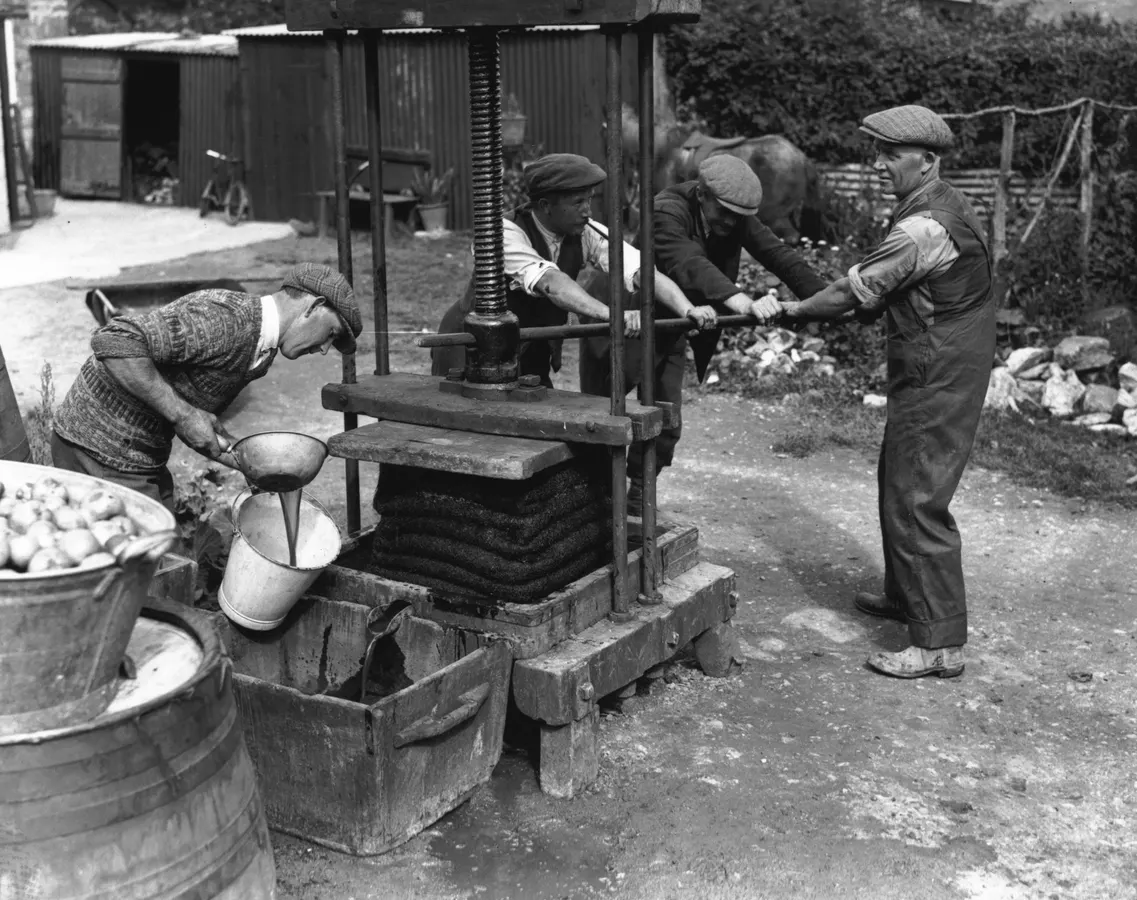By Felipe Schrieberg,Fox Photos,Senior Contributor
Copyright forbes

20th September 1934: Workers in Happyland, near Ashton Keynes, Wiltshire using a primitive iron cider hand press with horsehair mats to filter the juice. (Photo by Fox Photos/Getty Images)
Getty Images
Imagine picking up a bottle of wine only to find that its ingredients contain just 15% fermented grape juice, topped up with water, sugar syrup, and flavorings. Most drinkers would find this unthinkable, maybe even fraudulent. Yet in Europe, this is effectively the norm for cider. In Sweden, for example, a drink can legally be labelled “cider” if it contains just 15% apple juice, and even then it can be made from poor-quality concentrate.
“With wine, even the cheapest plank is 100% grape juice. If you ask a wine-producing body, ‘Would you like a situation where cheap wine was made from 50% grape juice?’ they would go, ‘No.’” says Andreas Sundgren, founder of multi-award winning Swedish ice cider producer Brännland Iscider, whose 100% juice cider is served in 3 star Michelin restaurants.
“In France, you’d probably go to jail for that’” he jokes.
This lack of clear definition leaves cider vulnerable to dilution, both literally and figuratively. Large producers use minimal juice, often consisting of imported concentrate, while small-scale makers striving for quality are left in a policy vacuum. The result is confusion for consumers and a marketplace skewed towards industrial-scale efficiency rather than craft and authenticity.
Without a coherent Europe-wide definition, smaller producers focused on quality cider made entirely out of apple juice say they are squeezed out, unable to compete and face an uphill climb to explain their value to consumers.
Finding a Definition for Cider
Across the EU, each country has its own approach. Though France and Spain demand that anything calling itself ‘cider’ is made entirely from apple juice, Scandinavia and other countries’ requirements (including the UK) are much more lax due to the interests of large-scale producers.
The wine comparison is useful because it shows how cider has fallen by the wayside on a policy level. Wine is universally protected as fermented grape juice, whereas cider occupies a grey zone where anything from 15% juice to 100% qualifies. This current situation is the result of competing pressures. As Daniel Emerson, co-founder of Ireland’s Stonewell Cider, explains: “Over 70, if not over 80% of the cider consumed in the European Union is predominantly made from glucose syrup with some apple concentrate, often less than 30% in content. Usually it’s around the 15% mark”.
Tom Oliver, founder of Oliver’s Cider and Perry in Herefordshire, points out that in the UK the situation is similarly murky, where a minimum requirement of 35% juice or concentrate is then gets subdivided into more specifications because of duty requirements. “We don’t have any specific definition of cider. Our definition is based purely on the duty aspect of it, and it doesn’t define what cider should be”, he notes.
Large-scale producers, many of them brewing companies, favour this system because it allows them to manufacture cider much as they would beer: scalable, efficient, and stable. Emerson comments: “If I want to make more cider, I’ll just order more glucose syrup and a bit more concentrate. I chuck a shed-load of water in. I add a yeast, and it’s an efficient process.”
Emerson, Sundgren and Oliver made clear that they don’t have a problem with these mass-market products per se, their concern is that they are classified as ‘cider’ like their own 100% juice products. It bothers them that a drink made mostly from concentrate and glucose syrup can take advantage of a wider consumer perception that ‘cider’ as made entirely from fruit.
Small producers have been pushing for reform particularly since the UK, by far the world’s largest cider market, left the EU. In 2023, the European Commission even proposed a category-wide minimum of 50% juice content, but now faces heavy pushback from industrial cider makers, who argue that raising juice content would devastate their business models.
The result is an impasse. Big producers fear regulation will eat into profits, while smaller ones cannot rely on a legal framework to distinguish their work. Consumers are left in the dark, unable to tell the difference between a cider made from 100% juice and one made from imported concentrate and glucose syrup.
How High Quality Cider Producers and Apple Farmers Are Affected
For small, quality-driven producers, the lack of definition is not a theoretical problem, it’s existential. Their raw material is fresh juice, which costs significantly more than sugar syrup and concentrate. As Emerson explains: “From my perspective as a business, we only make fresh juice cider. Why is my product more expensive? Because my primary ingredient isn’t water or even concentrate, it’s fresh juice. That’s something the consumer needs to know”.
Without transparency, consumers assume all cider is broadly similar. Oliver highlights the difficulty: “When you’re wishing to allow the consumer to understand why your products need to attract a higher price, you do need to be able to resort to the quality of your ingredients and the authenticity of your product. But if the consumer does not have any understanding of that authenticity, then it makes it difficult”.
The consequences ripple beyond individual businesses. Farmers growing apples who rely on cider makers find themselves squeezed as large producers move away from fruit altogether. Emerson describes receiving calls from growers desperate to sell surplus apples: “One farmer here keeps calling me, and he said, ‘Look, I’ll give them to you this year. I just don’t want to see them rot in the ground’”. Without stable demand, orchards are being grubbed up, further eroding the agricultural base needed for quality cider production.
Sundgren sees parallels with the wine industry. In wine, even cheap bottles are 100% grape juice, tied to grape varieties and regions that build consumer trust and long-term value. By contrast, he argues, cider “has literally become diluted as a term and as a product”. The lack of definition prevents cider from developing premium tiers and distribution channels. “Most of our distributors are fine wines distributors, with one or two exceptions, because there’s no business. It’s impossible to do business as a distributor of quality cider on a longer term and make money”.
The common thread is that without a clear, enforceable definition, quality-driven cider remains marginalised—an afterthought in a marketplace tilted towards efficiency and volume.
Is There a Brighter Future for Cider?
The debate over cider’s definition in Europe is far from settled, but smaller producers are increasingly vocal about the need for change. Within the AICV, the European Cider and Fruit Wine Association (of whom Emerson was recently Chairman), discussions have coalesced around a possible two-tier structure: one category for 100% juice ciders, and another for industrially made products with lower juice content. Not everyone agrees, but perhaps the momentum is shifting toward some form of transparency.
As Oliver notes, progress will require cooperation: “For us to have a real say, we really have to work together… my hope now is there’s some new intent coming through”. Emerson echoes this, pointing out that even some large players see the value of clear rules to simplify trading across borders.
For Sundgren, the issue is about using regulatory standards to give cider the same space to grow that wine has enjoyed, for the benefit producers big and small: “If cider had been able to take the route of wine, there would have been better margins, larger sales in the upper end of the category and it wouldn’t have adversely affected the lower end”.
Overall, cider sales in the E.U. have remained steady in recent years, albeit this mostly consists of industrial-scale products. Smaller producers account for a tiny percentage of this market.
Yet until clearer definitions are established, however, consumers will remain uninformed, farmers unsupported, and producers focused on quality forced to fight uphill. The hope is that a clearer framework, if it emerges, will finally give cider the chance to be taken seriously as the complex, varied, and magical drink it truly is.
Editorial StandardsReprints & Permissions



